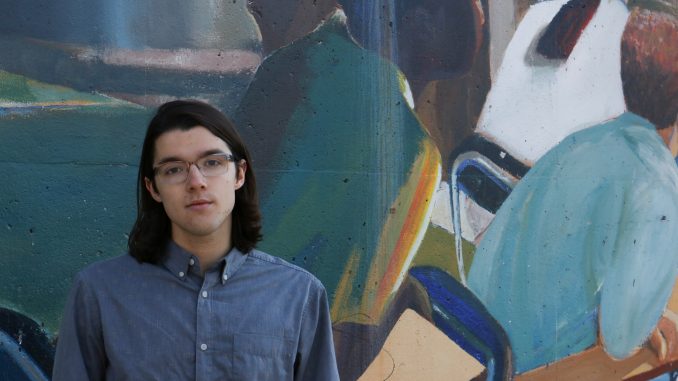
Last November, three students had the same idea.
“All three of us had the same sense of, ‘Something is off-balance about the relationship between the university and the community of North Philadelphia,’” said 2015 media studies and production alumnus Tyler Horst.
Horst was taking the “Genres in Media Production” class with Vanessa Edwards and Blake Morgan-Gamber. All three were asked to create an idea for a documentary—and Horst, Edwards and Morgan-Gamber pitched the same thing.
“We wanted to really get to know the actual history and stories of people in this community and seeing … What can be done better about having an actual dialogue?” Horst said.
Classmate Jessica Pacheco joined the team and the beginnings of what would come to be, “We All Live Here” were formed. The documentary set out to examine the relationship between North Philadelphia and Temple. The students focused on issues like gentrification, the closure of William Penn High School and the expansion of Temple’s boundaries into the existing neighborhoods.
Though the documentary officially premiered last December, it’s “still relevant,” Edwards said, because of “the cycle of redevelopment and reconstruction and real estate” going on not only in Philadelphia, but “in every city across America.”
For Horst, the reports of the new on-campus football stadium made him feel like the team hasn’t done their work just yet.
“The movie’s been made, but people still need to be in dialogue about this kind of thing,” he said.
The students tried to fashion the documentary like a conversation—weaving the interviews of community members and administration together without a voice over. The documentary was meant to be objective, but the group did “inherently have an argument,” said 2015 media studies and production alumna Morgan-Gamber.
“We were trying to give a voice to people whose voices couldn’t or hadn’t been heard before, so I think within that, there’s inherently an argument, but I don’t think we were biased one way or another,” Morgan-Gamber said.
Finding individuals who wanted to speak with the students was one of the documentary’s biggest challenges, Horst said. Community members and administration representatives seemed reluctant to speak with the film crew.
They tried visiting local businesses and telling people about their project. Though many individuals were initially excited, “some people were really afraid or nervous about being on camera saying something bad about Temple,” Horst said, which was a “wakeup call” for the team.
“If you feel like … You might not be able to afford to live here, what else can you lose?” he added. “That sense of powerlessness and not really knowing how you could put yourself at risk …”
“I’m an eternal optimist,” Morgan-Gamber said. “I was hoping to give Temple the benefit of the doubt, but I was really more and more disappointed by what we uncovered.”
Horst walked away with a sense the university’s community outreach was “not genuine.” Instead, he said, it seemed more like “Temple wants to do what they’re going to do and try the best they can to get that.”
“There was a lot of going through the motions on Temple’s end,” Morgan-Gamber said. “There are initiatives made by Temple that were well-intentioned, but didn’t seem to follow through.”
Representatives from the university’s Office of Community Relations were unable to speak with The Temple News, citing not having seen the documentary, therefore not being able to offer comment.
For Tyrone Reed, a featured interviewee in “We All Live Here,” the documentary was important because both students and administrators might see it.
“We felt that it might have even gotten to the high echelons, maybe the board and maybe the president or the provost,” said Reed, the president of the Committee for a Better North Philadelphia. “So we kind of felt that it may filter through the ranks of the institution.”
The documentary is still “very, very timely,” Reed said, because many of the issues have not changed, and he is still left wondering why the community can’t benefit from the university’s ongoing developments.
A university spokesman said Temple makes important contributions to the city every day.
“Temple offers millions of dollars in scholarships to local residents, delivers important healthcare services across the region and engages in dozens of collaborations with the School District of Philadelphia,” the spokesman wrote in an email. “As Philadelphia’s public university, we take great pride in being a vital part of our city and contributing to its success.”
With the 2014 acquistion of William Penn High School, Temple also plans to offer a job training center for the community affected by the school’s closure.
Even with all that, the community still feels left out, North Philadelphia resident Priscilla Woods said.
“It’s offensive that this university will do their planning, decide what they’re going to do, and not engage the community at all,” Woods said. “[They won’t] come to the community to say, ‘This is what we’re planning to do, what do you think? How do you think this will impact you? And while we’re doing this, are there some tangible needs that we can provide for the community?’”
“I feel like universities should be one of those institutions that are trying to set a standard for social progress,” Horst said. “I want that.”
“It could be different,” Woods said. “It could just be different.”
Victoria Mier can be reached at victoria.mier@temple.edu.
Editor’s note: Tyler Horst was previously a freelance reporter and photographer for The Temple News. He did not contribute to the editing process of this article.



I enjoyed reading this article. Is the film available to watch online?
https://vimeo.com/118509447